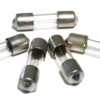I thought I'd mentioned the success I've had with Ox-Gard Anti-Oxidant Compound. I found it at Home Depot about 10 years ago when I had finished restoring my car and the fuses started acting up.
http://www.amazon.com/Gardner-...mpound/dp/B000BODU66At least for me, the fuses that were the biggest problem were the ones I'd put on relays. I'm not sure why. Anyway, after I'd cleaned them all with contact cleaner and scotch bright (as suggested above) and then applied the Ox-Gard I haven't had any problems. Ox-Gard was developed to prevent aluminum wired houses from burning down! Turns out the ALU would oxidize, resistance would build, wire joints would heat up and houses burned.
I wondered about the comments above about dielectric grease. Looking around a bit I found this article:
http://www.w8ji.com/dielectric...onductive_grease.htm Turns out do not insulate metal to metal contacts:
"One incorrect logic is the "dielectric" in "dielectric grease" means the grease should only be used to insulate. All greases work by the low viscosity allowing the grease to completely push out of areas with metal-to-metal contact. Dielectric grease is just better at holding off high voltages over long paths."
And they help prevent oxides and corrosion from forming.
But, there may be something better. A good friend is a high-end audio kind of guy who lived near the ocean and had some magic stuff to fix his contact problems. Looks like CAIG DeOxIT (in its various forms) is what is used now for all kinds of contact problems.
http://www.caig.com available on Amazon and elsewhere. Looks like this is
http://www.amazon.com/Booster-...ricant/dp/B0002BBVN2 should do the trick for almost any electrical contact problem.


